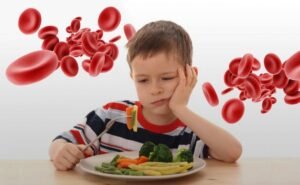What is Anemia in Children?
Anemia in children is a condition characterized by a lower-than-normal amount of red blood cells or hemoglobin in the bloodstream, leading to reduced oxygen-carrying capacity. Red blood cells are essential for transporting oxygen from the lungs to all parts of the body. Hemoglobin, a protein contained within red blood cells, binds to oxygen molecules and facilitates their transport throughout the body.
When a child has anemia, their body may not receive an adequate supply of oxygen, which can lead to symptoms such as fatigue, weakness, and pallor. There are various types of anemia that can affect children, including:
- Iron-Deficiency Anemia: This is one of the most common forms and occurs due to a lack of iron in the body to produce hemoglobin. Causes can include insufficient dietary intake of iron-rich foods or conditions that impair iron absorption in the gut.
- Sickle Cell Anemia: An inherited blood disorder where red blood cells become rigid and sticky, taking on a crescent or sickle shape. This abnormal shape hinders their ability to flow smoothly through blood vessels and deliver oxygen effectively.

Symptoms of Anemia in Children
Symptoms of anemia in children may vary depending on the underlying cause and severity of the condition. Common signs include:
- Fatigue: Constant tiredness and weakness, impacting a child’s energy levels.
- Pale Skin or Mucous Membranes: Anemic children may appear visibly paler, especially around the face, lips, and inner eyelids due to decreased red blood cell production and reduced oxygen levels.
- Shortness of Breath: Difficulty breathing during physical exertion or even at rest, leading to feelings of breathlessness, rapid heart rate, and chest discomfort.
- Other Symptoms: Dizziness, cold hands and feet, headaches, irregular heartbeat, and chest pain.
In severe cases or when left untreated for prolonged periods, anemia can lead to complications such as developmental delays in growth and cognitive function due to chronic oxygen deprivation. Identifying these symptoms early is crucial for prompt diagnosis and treatment intervention to prevent further health complications.
Types of Anemia in Children
Anemia can manifest in various forms, each with its unique characteristics and underlying causes:
- Iron-Deficiency Anemia: This occurs when the body lacks enough iron to produce adequate hemoglobin. Commonly caused by a diet low in iron-rich foods or poor absorption of iron.
- Hemolytic Anemia: Characterized by the premature destruction of red blood cells, this can be inherited or acquired. Symptoms may include jaundice, dark urine, and an enlarged spleen. Treatment depends on addressing the underlying cause.
- Sickle Cell Disease: A hereditary form primarily affecting individuals of African descent, leading to misshapen red blood cells that clump together, causing blockages and decreased oxygen delivery to tissues. Management includes regular monitoring and pain management.
Care for Children with Anemia at Rush
At Rush, we prioritize comprehensive care for children with anemia to ensure they receive the best possible treatment and support. Key aspects include:
- Timely and Accurate Diagnosis: Utilizing advanced diagnostic tools to identify the specific type of anemia, allowing tailored treatment plans.
- Nutritional Support: Nutrition is crucial for managing anemia. Our team develops personalized nutrition plans to ensure adequate intake of iron, vitamin B12, folic acid, and other essential nutrients.
- Continuous Monitoring: Regular check-ups to track treatment progress and address concerns or complications promptly.
Rush Excellence in Anemia Care for Kids
At Rush, we are dedicated to providing excellence in anemia care for children. Our multidisciplinary team works tirelessly to ensure each child receives tailored care.
- Early Detection and Diagnosis: We use state-of-the-art diagnostic tools to accurately assess hemoglobin levels and identify the underlying cause of anemia, leading to better treatment outcomes.
- Ongoing Monitoring: Our team tracks each child’s progress throughout their treatment journey, adjusting interventions as necessary to ensure optimal results.
Anemia in Children Providers at Rush
Anemia requires specialized healthcare expertise for accurate diagnosis and optimal treatment. At Rush University Medical Center, our dedicated team includes:
- Pediatric Hematologists: Specialists focused on diagnosing and managing blood disorders in children.
- Pediatric Nurses: Support young patients by administering treatments and educating families on managing the condition.
- Social Workers and Child Life Specialists: Address the emotional and psychosocial needs of children and their families during treatment.
Conclusion
Anemia in children is a serious health condition that requires attention and proper management. Recognizing signs and symptoms early is crucial in providing timely interventions to prevent complications.
At Rush, we offer excellence in anemia care by combining cutting-edge medical knowledge with compassionate support. Our dedicated team is committed to guiding children and their families towards better health. With early detection and appropriate interventions, children with anemia can lead healthy and fulfilling lives.
By raising awareness and fostering collaboration within the medical community, we can continue to improve outcomes for children affected by this condition. Together, let us strive towards a future where every child has the opportunity to thrive despite facing health challenges like anemia.